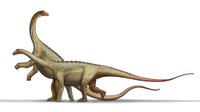| Lecho Formation | |
|---|---|
| Stratigraphic range: Early Maastrichtian ~ | |
| Type | Geological formation |
| Unit of | Salta Group |
| Underlies | Yacoraite Formation |
| Overlies | Los Blanquitos Formation |
| Lithology | |
| Primary | Sandstone |
| Location | |
| Coordinates | 26°06′S 65°24′W / 26.1°S 65.4°W |
| Approximate paleocoordinates | 28°36′S 52°00′W / 28.6°S 52.0°W |
| Region | Jujuy, Salta |
| Country | Argentina |
| Extent | Salta Basin |
The Lecho Formation is a geological formation in the Salta Basin of the provinces Jujuy and Salta of northwestern Argentina. Its strata date back to the Early Maastrichtian, and is a unit of the Salta Group. The fine-grained bioturbated sandstones of the formation were deposited in a fluvial to lacustrine coastal plain environment.
Dinosaur remains are among the fossils that have been recovered from the formation.[1]
According to Frankfurt and Chiappe (1999), the Lecho Formation is composed of reddish sandstones. The Lecho is part of the Upper/Late Cretaceous Balbuena Subgroup (Salta Group), which is a near-border stratigraphic unit of the Andean sedimentary basin. Fossils from this formation include the titanosaur Saltasaurus along with a variety of avian and non-avian theropods.
Fossil content
| Aves and Dinosaurs from the Lecho Formation | ||||||
|---|---|---|---|---|---|---|
| Genus | Species | Location | Stratigraphic position | Material | Notes | Images |
| Elbretornis | E. bonapartei | Scapula, partial coracoid, humerus, partial radius, partial ulna[2] | Enantiornithes | |||
| Enantiornis[3] | E. leali[3] | "Postcranial elements"[4] | Enantiornithes | |||
| Lectavis[3] | L. bretincola[3] | "Tarsometatarsus and tibiotarsus"[4] | Enantiornithes | |||
| Martinavis | M. minor | Partial humerus[2] | Enantiornithes | |||
| M. saltariensis | Humerus[2] | |||||
| M. vincei | Humeri[2] | |||||
| M. whetstonei | Partial humerus[2] | |||||
| Noasaurus[3] | N. leali[3] | Isolated elements from the head and foot, as well as a verebral arch.[5] A putative oviraptorosaurian cervical vertebra [6] is likely to belong to this taxon.[7] | Noasaurid abelisaurs |  | ||
| Saltasaurus[3] | S. loricatus[3] | "Partial skeletons of at least [six] individuals, including jaws and armor."[8] | Saltasaurid titanosaurs |  | ||
| Soroavisaurus[3] | S. australis[3] | "Tarsometatarsus and phalanges."[9] | Avisaurid enantiornithes | |||
| Yungavolucris[3] | Y. brevipedalis[3] | "Tarsometatarsi"[9] | Enantiornithes | |||
See also
References
- ^ Weishampel et al., 2004, "Dinosaur distribution (Late Cretaceous, South America)." pp. 600-604
- ^ a b c d e Walker & Dyke, 2009
- ^ a b c d e f g h i j k l "63.7 Provincia de Salta, Argentina; 3. Lower Kirtland Formation," in Weishampel et al., 2004, p.603
- ^ a b "Table 11.1," in Weishampel et al., 2004, p.213
- ^ "Table 3.1," in Weishampel et al., 2004, p.49
- ^ Frankfurt & Chiappe, 1999
- ^ Agnolin & Martinelli, 2007
- ^ "Table 13.1," in Weishampel et al., 2004, p.270
- ^ a b "Table 11.1," in Weishampel et al., 2004, p.214
Bibliography
- Walker, _, and _ Dyke. 2009. Euenantiornithine birds from the Late Cretaceous of El Brete (Argentina). Irish Journal of Earth Sciences 27. 15–62. .
- Agnolin, F.L., and A.G. Martinelli. 2007. Did oviraptorosaurs (Dinosauria; Theropoda) inhabit Argentina?. Cretaceous Research 28. 785–790. .
- Weishampel, David B.; Peter Dodson, and Halszka Osmólska (eds.). 2004. The Dinosauria, 2nd edition, 1–880. Berkeley: University of California Press. Accessed 2019-02-21. ISBN 0-520-24209-2
- Frankfurt, N.G., and L.M. Chiappe. 1999. A Possible Oviraptorosaur From The Late Cretaceous of Northwestern Argentina. Journal of Vertebrate Paleontology 19. 101–105. .

